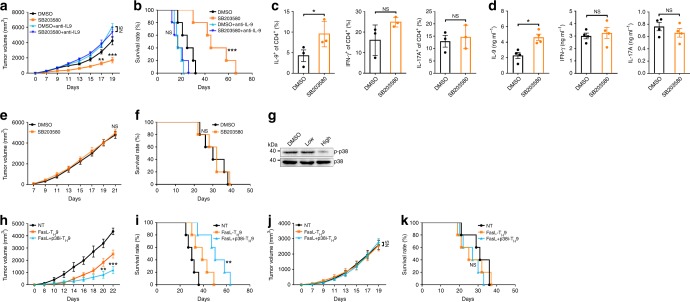Fig. 7.
p38 inhibitor exerts antitumor activity by inducing T helper type 9 (TH9) cells. a, b Tumor growth (a) and survival (b) of wild-type (WT) mice that received a subcutaneous injection of LLC-OVA cells followed by an intraperitoneal injection of SB203580 (0.5 mg kg−1) with or without an intravenous injection of 100 µg of anti-IL-9-neutralizing antibodies every other day (n = 5). c Flow cytometric analysis of the frequencies of IL-9+ (interleukin-9+), IFN-γ+, and IL-17A+ cells among CD4+ T cells in the TILs of the mice described in a 20 days after tumor inoculation (n = 2–3). d Enzyme-linked immunosorbent assay (ELISA) measurements of IL-9, IFN-γ, and IL-17A levels secreted by OVA323–339-stimulated TILs from the mice described in a 20 days after tumor inoculation (n = 3). e, f Tumor growth (e) and survival (f) of Faslpr → WT mice that received a subcutaneous injection of LLC-OVA cells followed by an intraperitoneal injection of SB203580 (0.5 mg kg−1) every other day (n = 5). g Western blotting analysis of p-p38 expression in colonic tissues from mice that received intraperitoneal injection of low- (0.5 mg kg−1) or high-dose (10 mg kg−1) SB203580 every other day for a total of 11 injections. h–k Tumor growth (h) and survival (i) of WT mice or tumor growth (j) and survival (k) of Il9r−/− mice that received a subcutaneous injection of B16F10-OVA cells followed by no transfer (NT) or intravenous injection of 2 × 106 OT-II FasL-TH9 or FasL + p38i-TH9 1 and 6 days later (n = 5). NS, not significant; *P < 0.05, **P < 0.01, and ***P < 0.001 (unpaired Student’s t test: a, c–e, h, j; log-rank test: b, f, i, k). Compared with dimethyl sulfoxide (DMSO) in a, b; compared with FasL-TH9 in h–k. Representative results from three independent experiments are shown (mean and s.d.)

